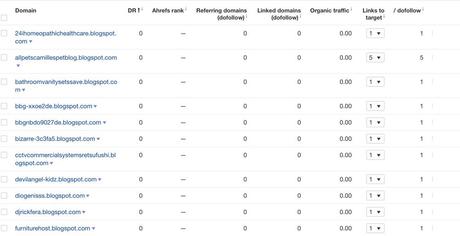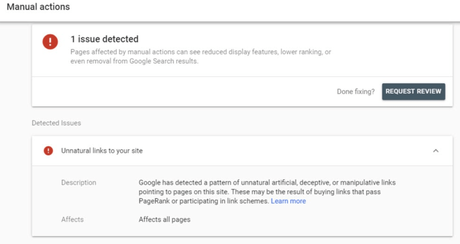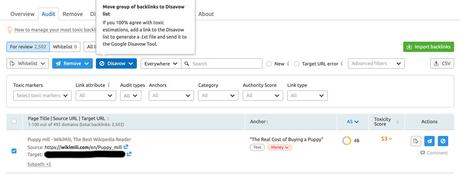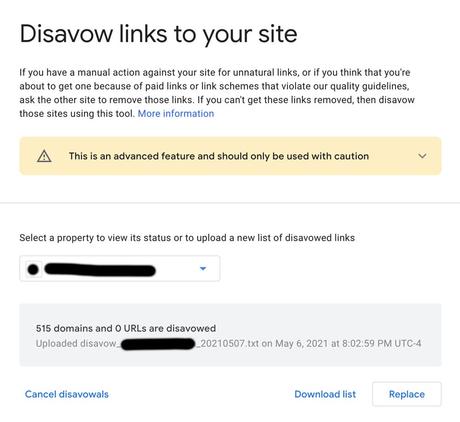If you are unsure of when, why, and how to invalidate links, you are not alone.
We all know that backlinks are critical to your SEO success, but the quality of those backlinks can make all the difference in that success.
This post will tell you when and how to submit a Google disavow file, which is important for protecting your domain.
Let's dive in - but first, what is the disavow tool?

What is the disavow tool?
The Disavow tool gives you the option to ask Google to ignore poor quality backlinks to your website.
When submitting a disavow file to Google, ask Google to ignore certain links pointing to your domain. They are under no obligation to respect your request, but if they do, these links will not be used to determine your ranking in search results.
However, it is important to understand that disapproving backlinks does not remove them from your backlink profile.
Do you actually need to use the Disavow tool?
Google made it clear that you only want to use the Disavow tool if you can need to.
They recommend using it if you have a manual spam penalty or if you have knowingly participated in link building practices that could harm you.
In 2019, John Mueller, Senior Webmaster Trends Analyst at Google, spoke about the Disavow tool during office hours at Google Webmaster Central.
He says, "I think for most of the websites out there, pretty much the vast majority of websites, you don't need to use the disavow tool. That's why we kept the disavow tool so separate from the search console that you don't have to try to use the disavow tool as it looks like this normal part of the search console that everyone should be using. "
Müller says:[The disavow tool] is really something you only really need in really extreme cases. "
To decide whether you could benefit from a disavow, you need to analyze your backlink profile, which you will learn more about below. But if you knowingly participated in unethical backlinking practices, opting out is likely to help.
What is a "bad" backlink?
Before we explain how to disavow you, it's important to understand what makes a backlink bad.
Google considers any link created to manipulate a website's PageRank or ranking as a bad link. They want you to work on creating great content that links naturally!
If you have participated in any type of link building campaign on purpose, chances are that you have bad backlinks.
This could include:
- Purchased backlinks
- Link schemes
- Product for backlinks
- Link exchange
- Footer Links
You might look at your backlinks in different tools and see a lot of spammy looking backlinks and think you need to get rid of them - but you don't have to worry.
Google will understand and ignore spam links to a certain extent.
As an example, here are some backlinks from a website pulled by Ahrefs. These are all spam, and none of them have DR ratings:

I wouldn't go out of the way to disavow these as these are likely backlinks that many websites have, and Google is smart enough to know that we didn't create them to tamper with our backlink profile.
When should you create a disavow file?
Google has stated that most websites do not have to invalidate links and should only be used in certain circumstances.
Below are some examples of when a disavow is recommended or required.
1. Manual action: unnatural links to your site
This is the only time you're dying to file a disavow. If your website has been subject to a manual penalty for link building practices, disavowing links is a must to remove that penalty.
If your website is connected to Search Console - and it should be - you will be notified when any manual action is taken on your website.
At this point you would start by analyzing the backlinks in Search Console and trying to find the links that might be violating Google's guidelines.
If you find offensive backlinks, the first step is to contact the owner of the website that the backlink is on and ask them to remove it. If that doesn't work, you can try using a disavow file.
After removing or invalidating the links, you can select the Request Review button on your Manual Actions report to ask them to remove the action.

2. Link Schemes
If you knowingly participated in link programs, you can benefit from adding them to your disavow file. These are links that you - or someone you may have hired - paid for. These could be links to private blog networks (PBN) or even guest posts on websites that are not relevant to your niche.
3. Directories
Long ago, adding profiles to any existing directory with a link to your website with your "money keyword" as the anchor text was all the rage. Maybe it's your fault, or the SEO you hired - but these are backlinks that should be removed. If you can remove them manually this is best, but it is recommended that you add them to the disavow if you can't remove the link.
4. Comments
Another old tactic was to spam comments on other blogs and add catchy anchor text in the comments field or even for the name field.
If you have backlinks from comments, directories, or editorial links with anchor text like "buy red widgets" or "best tennis shoes", it is recommended that you add these to your disavow file if you cannot remove or change the link. Usually these types of links are expected to be your first name or brand name.
Find all of your backlinks
To do the most accurate analysis, you need to get as much backlink data as possible and understand how that data is analyzed.
You can use a variety of tools to check your backlinks, and you can download them all into a spreadsheet to check manually, or do some analysis right from the tool.
Here are some options of tools you can use to find backlinks:
1. Google search console.
In Google Search Console, you can go to the links section and click the Export External Links button and then click the More Sample Links option for a full list of backlinks to your website.
2. Semrush, Ahrefs, Moz or your preferred tool.
Export your list of backlinks and merge them with your Google Search Console file or analyze your data in the software.
3. A link audit tool.
There are some tools that can really minimize your time auditing your backlinks, such as LinkResearchTools.
Semrush also has a backlink audit tool that will display all of your backlinks and assign them a toxicity rating based on a variety of factors. You can work right from your dashboard to evaluate the links and see if they are really toxic or not.
If so, you can add them to a disavow directly from the tool. When you are done with the review, you can download the formatted Disavow .txt file and send it to the tool.
While this is a useful tool, it doesn't have all of your backlinks in its database! You should still do a manual check using other tools.

Create a disavow file
After you've rated your links, you can create the disavow.txt file that will be uploaded to Google Search Console.
Create a Disavow.txt file
Below are some guidelines from Google for creating your file.
- The file name must end in .txt
- The file size cannot exceed 2MB and 100,000 lines
- Each URL should be on its own line
- If you want to disavow an entire domain, start the line with Domain:
- If you want to invalidate a URL, you can simply enter the URL
Below is a sample part of a disavow file I recently created as an example.
You can add comments by adding a # in front of the text, these lines will be ignored by Google.

If you want to test your disavow file before uploading it, you can use the Disavow File Testing Tool developed by Fili Wiese, a former Google engineer.
Upload a disavow file
Once you have completed your disavow file, it can be uploaded to the disavow tool in the Google Search Console.
Below are some easy steps to take to upload your disavow.
- Sign in to the Google Search Console
- Go to https://search.google.com/search-console/disavow-links
- Select the property you want to add a disavow file to
- Click the Upload Disavow List button and find your .txt file to add

If you uploaded a previous disavow.txt file, your new one will overwrite it. If you have problems with your file, you will receive error messages and prompt you to upload a corrected version.
While there is no guarantee that submitting a disavow file will help, there have been reports of success with using it.
It will take Google some time to process the information you have uploaded, so be patient.
There is no way to really know if the disavow.txt file is doing what you want it to do, but keeping an eye on your rank, organic traffic, and impressions could be a good indicator.

